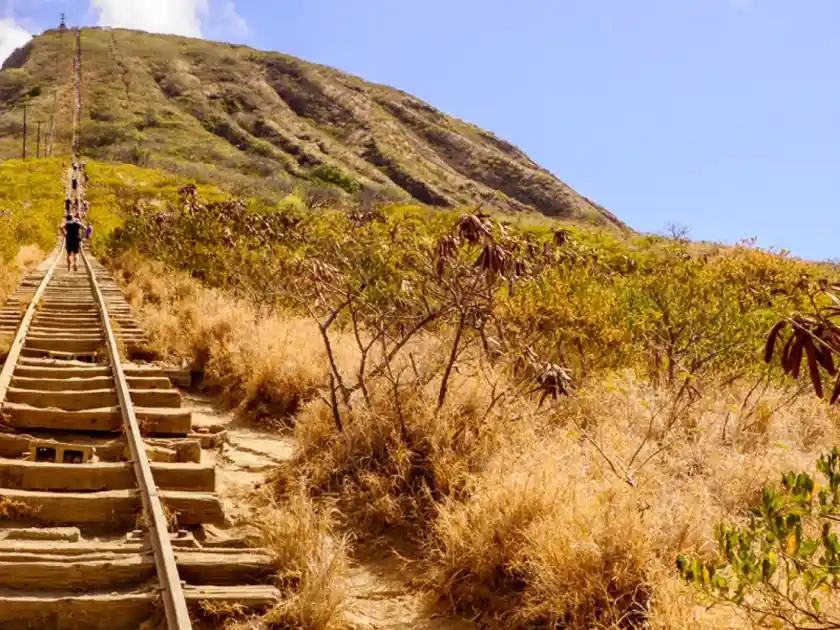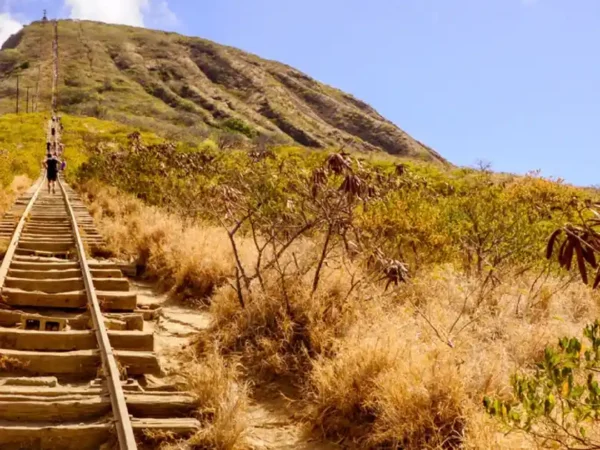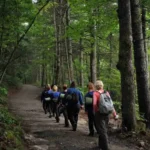The Koko Crater Railway Trail, known as the Koko Head Stairs, is one of Oahu’s most popular hikes, offering breathtaking panoramic views of the island’s southeastern coastline. This challenging trail in the Koko Head District Park is a must-do for adventure seekers visiting Hawaii. In this guide, we’ll explore everything you need to know about conquering the Koko Crater Railway Trail, from its history to tips for a successful hike.

History of the Koko Crater Railway Trail
The Koko Crater Railway Trail has a rich history dating back to World War II. The U.S. military originally installed the trail’s railway tracks to transport personnel and supplies to the bunkers and pillboxes at the top of Koko Crater. The tracks were used by a cable car powered by a winch system, making it easier for soldiers to access the military lookout points. Today, these tracks are no longer operational but serve as the staircase. That hikers climb to reach the summit of Koko Crater.
The Hike |What to Expect
Trail Difficulty and Physical Demands
The Koko Crater Railway Trail is not for the faint of heart. The trail consists of over 1,000 railroad ties that act as steps, creating a steep and strenuous climb. The elevation gain is about 1,200 feet over a relatively short distance of just under a mile, making the ascent steep and challenging. Hikers should be prepared for a workout that tests their endurance, balance, and determination.
The Bridge Section
About halfway up the trail, hikers will encounter a bridge section where the railway ties cross a gap in the mountain. This part of the trail can be particularly daunting for those fearing heights. Some hikers choose to traverse the bridge directly. Balancing on the railway ties. While others opt to bypass the bridge by taking a side path that offers a safer, albeit longer, route.
The Summit
Reaching the summit of the Koko Crater Railway Trail is a rewarding experience. At the top, hikers are greeted with panoramic views of the southeastern coastline, including Hanauma Bay, Diamond Head, and the expansive Pacific Ocean. The summit also features remnants of old military bunkers, adding a historical element to the scenic views. The accomplishment and the stunning vistas make the challenging climb well worth the effort.
Preparing for the Koko Crater Railway Trail
What to Bring
- Water and Snacks: The hike is physically demanding, and the Hawaiian sun can be intense. Bring plenty of water to stay hydrated, and pack light snacks for energy.
- Proper Footwear: Wear sturdy shoes with good grip, as the railway ties can be uneven and slippery, especially after rain.
- Sunscreen and Hat: There is little to no shade on the trail, so protecting yourself from the sun is crucial.
- Gloves: Some hikers prefer to wear gloves to help grip the railway ties and prevent blisters.
Best Time to Hike
The best time to hike the Koko Crater Railway Trail is early morning or late afternoon to avoid the midday heat. Sunrise hikes are particularly popular, offering cooler temperatures and stunning views as the sun rises over the ocean. However, be mindful that the trail can be crowded during these times, so plan accordingly.
Fitness Level Requirements
Due to the steep incline and the physical demands of the trail, a moderate to high fitness level is recommended for those attempting the Koko Crater Railway Trail. Beginners and those not accustomed to strenuous hikes should take it slow, rest frequently, and listen to their bodies. There’s no shame in taking breaks; many hikers often stop to catch their breath and enjoy the views.
Safety Tips for the Koko Crater Railway Trail
- Stay on the Path: Stick to the railway ties and avoid veering off the trail. The sides of the trail are steep, and off-trail excursions can be dangerous.
- Be Cautious on the Bridge: If crossing the bridge feels unsafe, take the bypass trail to the right. The extra few minutes it takes are worth the added safety.
- Watch Your Step: The railway ties are uneven and can be unstable in places. Please pay attention to where you step, especially on the descent, as it can be more challenging than the ascent.
- Check the Weather: Avoid hiking during or after heavy rain, as the trail can be muddy and the railway ties slippery.
- Bring a Buddy: Hiking with friends or groups is safer and more enjoyable. It’s also helpful to have someone there in case of an emergency.
Environmental Impact and Respect for Nature
The Koko Crater Railway Trail is a cherished natural attraction, and it’s essential to respect the environment to preserve it for future generations. Stay on designated paths to prevent erosion, take all your trash with you, and avoid picking plants or disturbing wildlife. The trail is also popular with locals, so practicing good trail etiquette. Such as yielding to faster hikers and keeping noise levels down, is appreciated.
Post-Hike Recovery and Nearby Attractions
Your legs will likely feel the burn after completing the Koko Crater Railway Trail. Stretching and rehydrating immediately after the hike can help reduce muscle soreness. For those looking to extend their adventure, the nearby Hanauma Bay offers excellent snorkeling opportunities, and Sandy Beach is a great spot to relax and enjoy the ocean. The Koko Marina Center also provides various dining options to refuel after your hike.
Conclusion
The Koko Crater Railway Trail is more than just a hike; it’s an adventure that challenges both the body and mind. Whether you’re a seasoned hiker or simply looking for a unique way to experience Oahu’s natural beauty. The trail offers an unforgettable journey with stunning views, historical remnants, and a rewarding sense of accomplishment. By preparing adequately, respecting the trail, and embracing the challenge, you’ll find that the Railway Trail’s is a highlight of any Hawaiian adventure.
Embark on this iconic hike and take in the sweeping vistas and rich history of one of Oahu’s most beloved trails. Whether you’re chasing a sunrise, seeking a challenging workout, or want to enjoy the island’s breathtaking landscapes, the Koko Crater Railway Trail promises an experience you won’t soon forget.
FAQ’s
Is the Koko Crater Railway Trail suitable for beginners?
The Koko Crater Railway Trail is challenging due to its steep incline and uneven railway ties. While beginners can attempt the hike, it's recommended to go slowly, take frequent breaks, and be prepared for a strenuous workout.
Are dogs allowed on the Koko Crater Railway Trail?
Yes, dogs are allowed on the Koko Crater Railway Trail, but they must always be kept on a leash. It's essential to consider the trail's difficulty and ensure that your dog can climb, especially in the heat.
What should I wear when hiking the Koko Crater Railway Trail?
Wear lightweight, breathable clothing suitable for warm weather and sturdy shoes with good grip. A hat, sunglasses, and sunscreen are also essential due to the lack of shade on the trail. Gloves can help grip the railway ties, especially during the descent.








